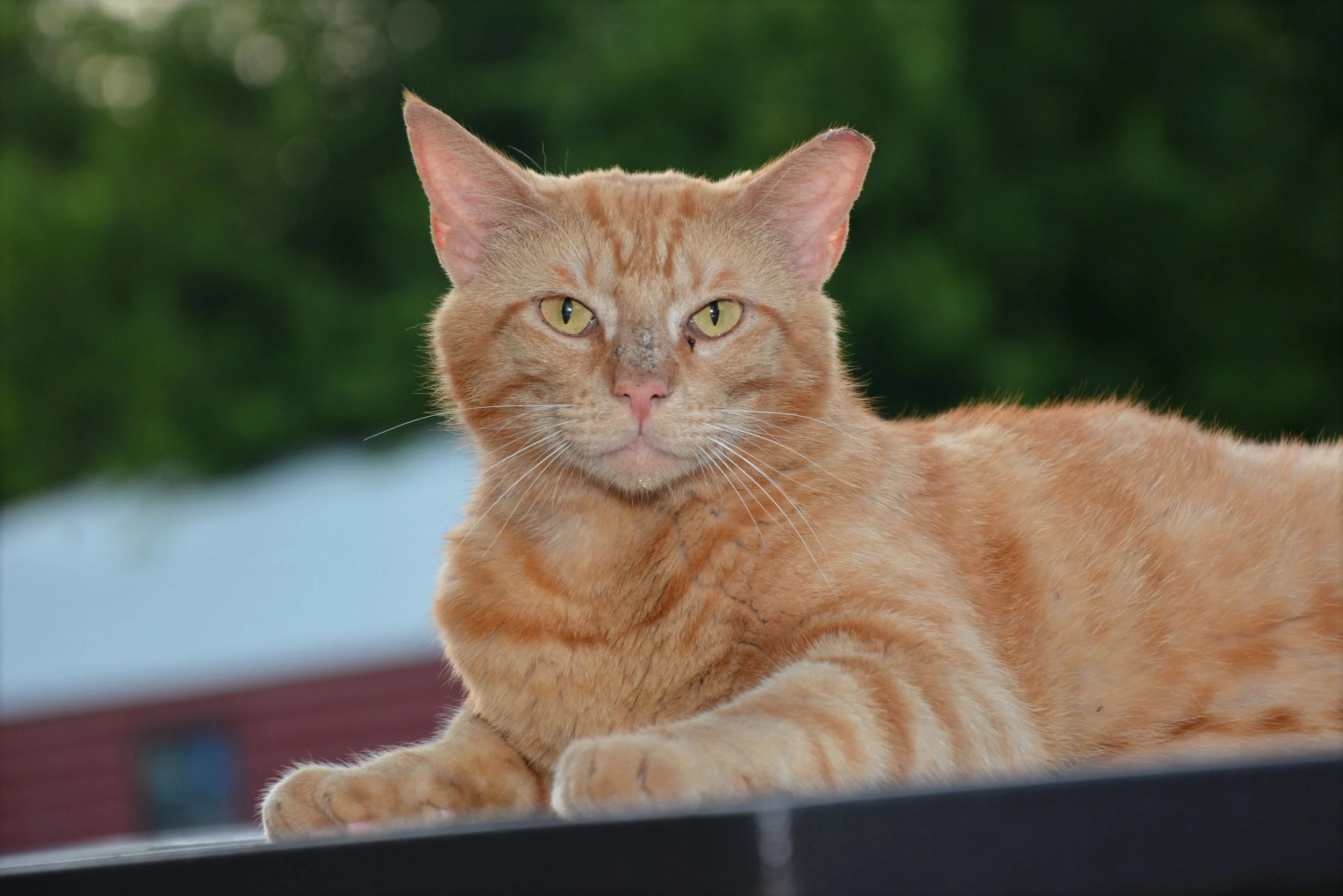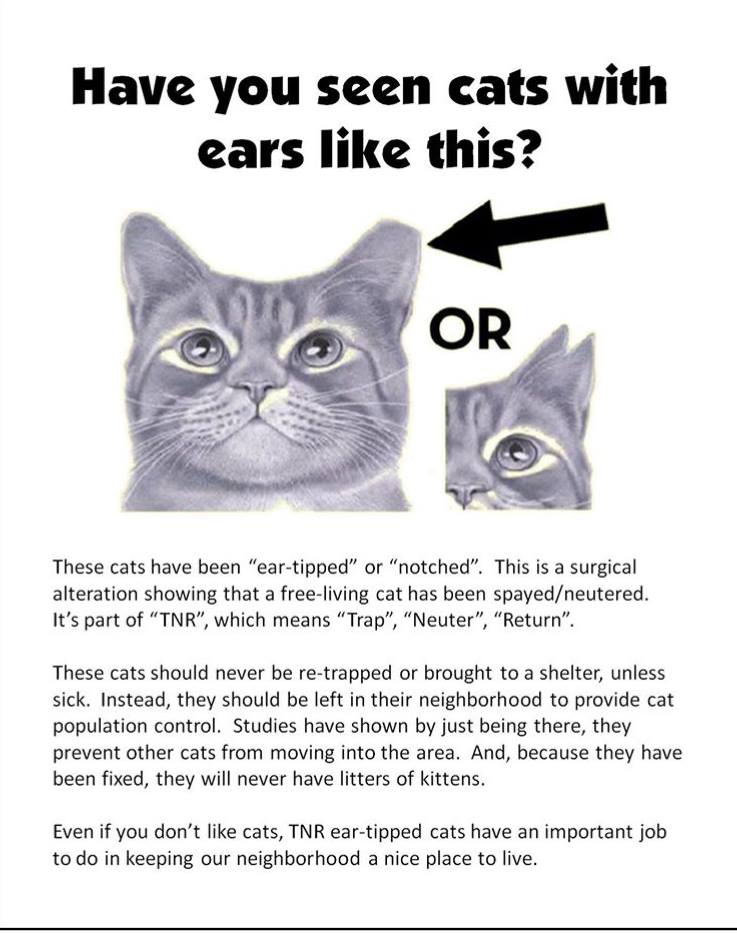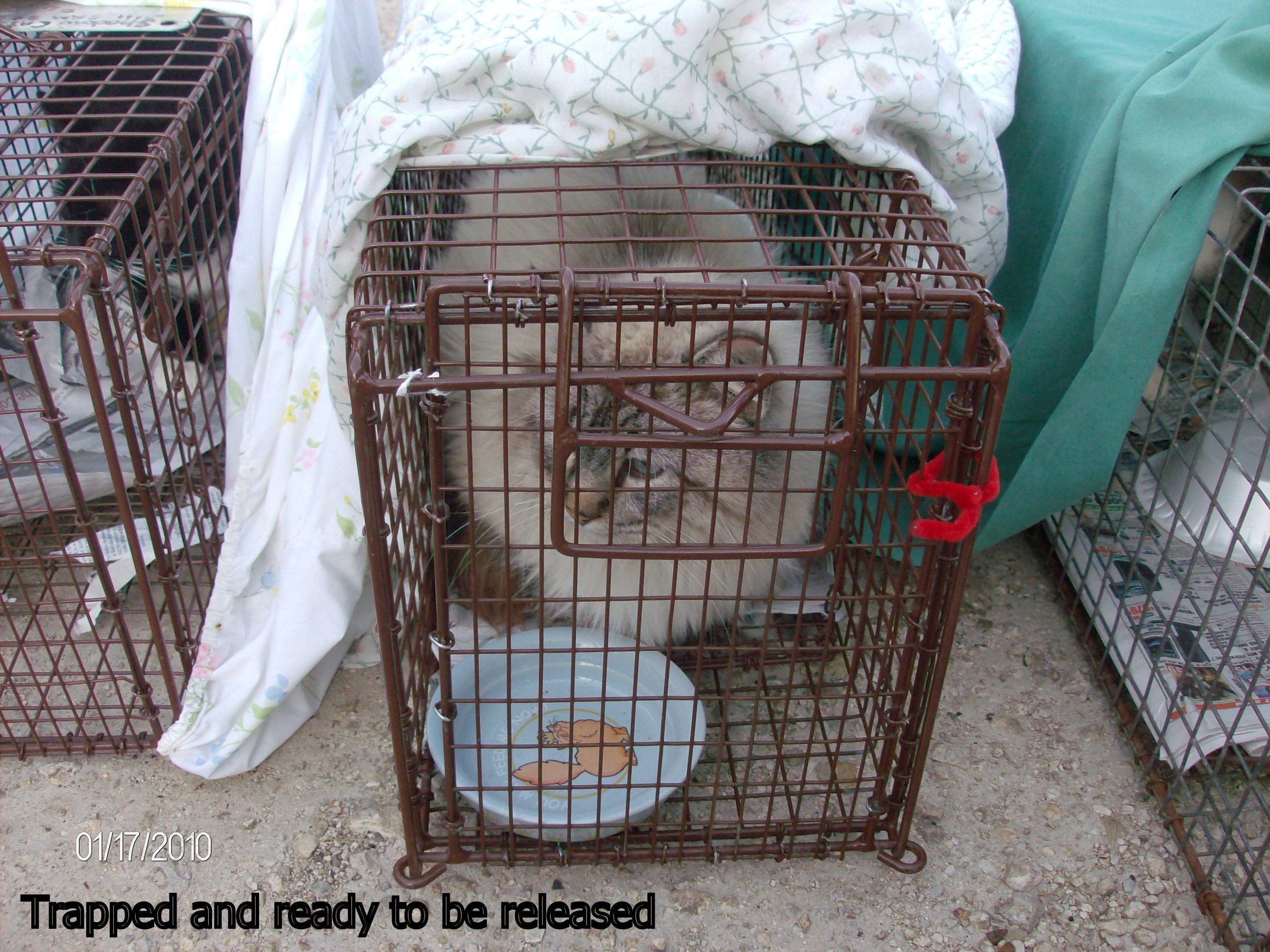About TNR
What is TNR?
TNR is short for Trap-Neuter-Return. You can recognize a TNR’d cat by the tipped ear. Some tips are straight, some jagged, some notched. These cats go by many names including feral, stray, homeless, free-roaming, ownerless, community or neighborhood cats.
The tipped ear tells you that the cat has been trapped, altered, and vaccinated for rabies. It is then usually returned to the same area where it was trapped but some may end up placed in colonies. In some instances, a trapped cat may go to a shelter or sanctuary or may even be adopted.
Relocating feral cats can be a difficult process and should only be attempted after every effort has been made to maintain the cats safely in their original territory. Besides being very dangerous for cats, it also is frequently ineffective. To learn more about relocation, visit this page on our website.
For more information about TNR, check out TNR for Stray Cats: Meaning, History, Statistics from Best Friends.
How to Trap a Feral Cat for TNR - video from the Kitten Lady
Community cats: scientific studies and data - Current science shows trap/neuter/return (TNR) as a valuable tool in managing community cat populations at the local level. From The Humane Society/HumanePro
And from Best Friends: Fact vs. Fiction: What Every Wildlife Professional Should Know About Free-Roaming Cats
Curious about what the Vacuum Effect is?
Click this link to learn more about it from Alley Cat Allies.
There are three classifications of feral cats:
Total Feral – a wild cat with no previous human contact or only negative contact
Semi-Feral – a shy or fearful cat that has had some positive human contact
Converted Feral – an abandoned domestic cat that has reverted to semi-feral behavior
Community Cat – a tame, stray cat that is being cared for by a Good Samaritan(s)
Please visit Feral Cat Terminology from Forgotten Felines for more helpful information on TNR terminology!
EVERYTHING BUT THE KITCHEN SINK! RESOURCES, TIPS, TRICKS and ADVICE for TNR Great information courtesy of The Jackson Galaxy Project
Found kittens?
Go here to find out what to do when you find kittens. Alley Cat Allies provides these helpful tips for trapping mom and kittens.
And be sure to visit our page on Kittens!
Did You Know….
The average life span of a feral cat is only 18 months?
These protocols from Best Friends provide just about everything you need to know for starting TNR… including what supplies to bring and how to protect your vehicle!
TNR versus SNR: What is the Difference?
SNR (shelter-neuter-return) is a shelter program that addresses cats that are surrendered to the shelter by community members or signed over to animal control. The cats are sterilized, vaccinated, and ear tipped then returned to their home area if known. TNR (trap-neuter-return) is a program where individuals trap free-roaming cats and transport them to and from local spay/neuter TNR clinics. The cats are picked up by the trapper and returned to the same area where they were trapped.
Texas Law Protects Animals from Abuse and Neglect - read what the SPCA says about animal cruelty laws in Texas
If you encounter injured wildlife… DO NOT TOUCH!
As animal rescuers, we want to help any animal that is suffering. But not touching the animal may save its life. It is actually illegal for a person to transport certain animals that are high risk for transmitting rabies, including any live species of fox, skunk, coyote, or raccoon.
If a human has touched one of these animals it must be euthanized and tested for rabies. If you see sick or injured wildlife, call Animal Control, 311, or a local animal rescue group such as Austin Wildlife Rescue, Critter Crusaders Wildlife Rehabilitation, and All Things Wild Rehabilitation.
Check out Thundering Paws’ instructions on how to humanely trap cats.
The Steps of Trapping
• Set up and prepare for trapping
• Label traps; line trap bottoms if desired
• Place traps carefully in usual feeding spots
• Bait traps
• Set traps
• Keep track of traps at all times
• Get away and stay quiet
• Cover trapped cats quickly
• Selective trapping and hard-to-trap cats
• Count traps
• Safe transport
When you have 2 cats in one trap
• Use a trap divider to separate cats
• Cover the trap
• Line new trap up w/first trap with sliding doors touching
• Ensure traps won’t separate
• Cover the new trap
• Open the doors of both traps
• Lift cover off the front of the first trap
• Close doors as soon as the cat enters the new trap
• Lock doors of both traps
• Remove the divider & cover the first trap
Frequently Asked Questions & Answers about TNR from Best Friends
TNR Facts
From the Best Friends website: Fiction: TNR doesn’t work.
Facts: The science is quite clear: There are only two ways proven to reduce, and eventually eliminate, a population of free-roaming cats: (1) intensive TNR efforts or (2) intensive eradication efforts…
Fiction: TNR is too costly to be feasible.
Facts: Studies show that TNR can actually save taxpayers money…
Fiction: Residents are opposed to TNR for managing the unowned, free-roaming cats in their neighborhood.
Facts: Results of a 2014 national survey commissioned by Best Friends revealed a 68 percent preference for TNR over impoundment followed by lethal injection of unadoptable cats (24 percent).7 More recently, a 2017 survey (also commissioned by Best Friends) found nearly identical results: 72 percent of respondents supported TNR, compared to just 18 percent favoring impoundment and lethal injection.
Fiction: TNR compromises the welfare of community cats.
Facts: Best Friends operates more large-scale TNR programs than any other organization in the country; as such, we are in a unique position to comment on the positive impact of these programs. Our firsthand experience, and evidence from a number of studies, shows that the vast majority of unowned, free-roaming cats are healthy — even thriving…
~~~~~~~~~~~~~
Check out this from Alley Cat Allies: Feral and Stray Cats—An Important Difference
TRAP-NEUTER-RETURN is a proven and humane solution.
TNR programs are a very successful method of decreasing feral cat populations and they are far less expensive for the public than other options. In addition, TNR reduces euthanasia rates at shelters as more space is available for more adoptable cats. Plus, TNR provide the best possible life for the cats themselves.
Regarding cats and birds…
Despite the large numbers of birds killed by cats in gardens, there is no clear scientific evidence that such mortality is causing bird populations to decline. This may be surprising, but many millions of birds die naturally every year, mainly through starvation, disease or other forms of predation. There is evidence that cats tend to take weak or sickly birds.
We also know that of the millions of baby birds hatched each year, most will die before they reach breeding age. This is also quite natural, and each pair needs only to rear two young that survive to breeding age to replace themselves and maintain the population.
Read more here from RSPB. And also check out what Alley Cat Allies has to say about this issue: To Save the Birds, Hold Humans Accountable—Not Cats
Listen to a radio interview with veterinarian Dr. Julie Levy about TNR.
And this is from BARC Animal Shelter in Houston on the issue of Cats and Birds:
Does putting community cats back into the community increase the risk for birds and wildlife to be harmed?
It has been argued that cats should be collected from the community, impounded and euthanized in shelters to protect wildlife and public health. However, euthanizing or removing all community cats from an area may lead to an increased population of other non-native species with an even more detrimental effect.
There are many more cats in the community currently than BARC can take in over a short period of time. The TNR program will decrease the number of cats that could potentially harm birds and wildlife over time. Click here to go to their page.
Why trap?
Save precious lives * reduces the numbers of cats in overcrowded shelters, thus reducing overall euthanasia rates * trapping can be loads of fun and healthier for you than spending the evening in a bar * trapping is a great way to meet lots of new people and spend time with your new friends * benefits communities by helping to reduce numbers of rats, snakes and other pests * reduces the numbers of kittens born to malnourished mama cats who may suffer before dying * reduces stress and improves the quality of life for community cats * AND trapping is really good karma and we can all use more of that!
Visit the TNR WORKS Facebook page to learn more about TNR, for helpful tips, to share what you know or post questions, and sometimes, just to enjoy some delightful cat humor!
RESOURCES:
From the City of Lubbock Animal Services
TNR Resources:
TNR Trap Setting Instructions: https://resources.bestfriends.org/article/humane-cat-trapping-instructions-tnr
Trap Setting Video: https://www.youtube.com/watch?v=vSnWZ4ex0N8&feature=youtu.be
Eartipping Info: https://www.alleycat.org/resources/feral-cat-protocol-eartipping/
TNR Online Class: https://sanantonioferalcats.org/tnr-classes/
TNR Research Studies: https://www.alleycat.org/resources/trap-neuter-return-research-compendium/
Equipment Suggestions: http://www.saveacat.org/where-to-buy-tnr-equipment.html
Care After Trapping: https://www.neighborhoodcats.org/how-to-tnr/trapping/caring-for-cats-in-traps
General TNR Info: http://www.saveacat.org/how-to-help-community-cats.html
The Vacuum Effect: https://www.alleycat.org/resources/the-vacuum-effect-why-catch-and-kill-doesnt-work/
Vacuum Effect Video: https://www.youtube.com/watch?v=U5V0e1L87gI
Working Cat Resources:
Relocation As A Last Resort: https://www.alleycat.org/community-cat-care/relocation-the-last-resort/
Safe Relocation Guide: https://www.alleycat.org/community-cat-care/safe-relocation/
Relocation Essentials: https://www.neighborhoodcats.org/how-to-tnr/colony-care/relocation
Acclimation Process: https://ocgainesville.org/acclimation-working-cats
Community Cat Management Resources:
Humane Deterrents: https://www.alleycat.org/community-cat-care/humane-deterrents/
How to Live with Cats in your Neighborhood: https://www.alleycat.org/resources/how-to-live-with-cats-in-your-neighborhood/
Winter Shelters: https://resources.bestfriends.org/article/how-help-outside-cats-winter
Caretaker Tips: https://www.neighborhoodcats.org/how-to-tnr/colony-care/caretaker-tips
Community Cat Feeding: https://www.neighborhoodcats.org/how-to-tnr/colony-care/feeding
Community Cat Best Practices: https://www.alleycat.org/resources/best-practices-community-cat-colony-care/
Protecting Community Cat Colonies from Predators: https://www.humanesociety.org/resources/coyotes-pets-and-community-cats











